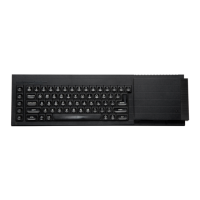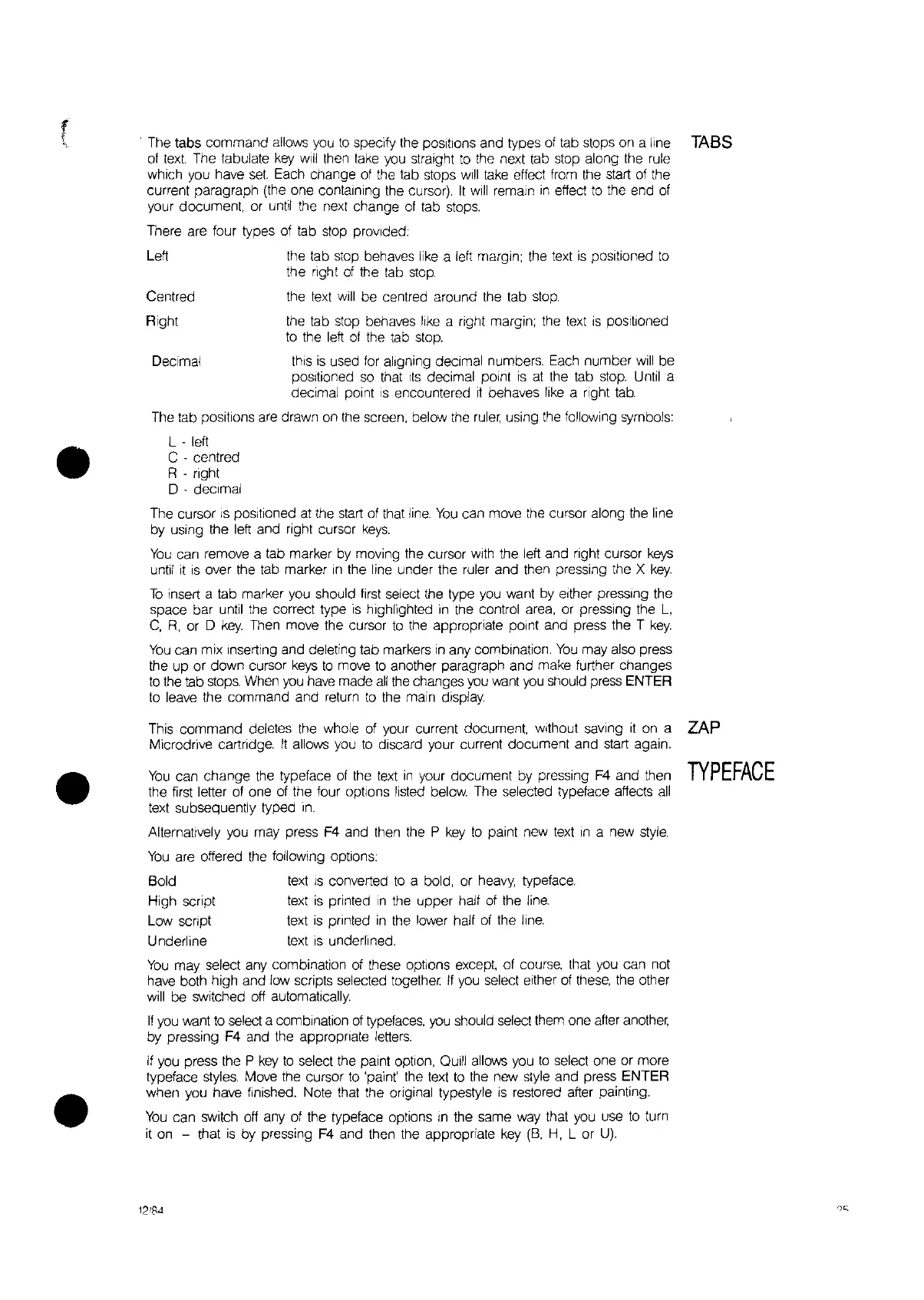•
•
. The tabs command
allows
you
to
specify
the
positions and types
of
tab
stops
on
a line
TABS
of
text The tabulate
key
will
then
take
you
straight
to
the next tab
stop
along
the
rule
which
you
have set Each change
of
the
tab stops
will
take
effect from
the
start
of
the
current paragraph
(the
one containing
the
cursor).
It
will
remain
in
effect
to
the end
of
your document, or
until
the
next change
of
tab
stops.
There
are
four types
of
tab
stop
provided:
Left
the
tab
stop
behaves
like
a
left
margin;
the
text
is
positioned
to
the right
of
the
tab
stop.
Centred the
text
will
be centred around
the
tab
stop.
Right
the
tab
stop
behaves
like
a nght margin;
the
text
IS
posItioned
to
the
left
at
the tab
stop.
Decimal
this
is
used
for
aligning decimal numbers.
Each
number
will
be
positioned
so
that
ItS
decimal
pOint
IS
at
the tab
stop.
Until
a
decimal
pOint
IS
encountered
It
behaves
like
a right
tab.
The
tab positions
are
drawn
on
the
screen, below
the
ruler using
the
following symbols:
L
-
left
C - centred
R
- right
D
- decimal
The cursor
IS
positioned
at
the
start
of
that
line.
You
can move
the
cursor along
the
line
by
uSing
the
left
and nght cursor
keys.
You
can remove a tab marker by moving the cursor
With
the
left
and right cursor
keys
until
it
is
over
the tab
marker
in
the
line under the ruler and then pressing the X
key.
To
insert a tab marker
you
should
first
select
the
type
you
want
by
either pressing the
space bar
until
the
correct type
is
highlighted
in
the control
area,
or pressing
the
L,
C,
R,
or D
key.
Then
move the cursor
to
the
appropriate
pOint
and press the T
key.
You
can mix Inserting and deleting tab markers
in
any combination.
You
may also press
the up or down cursor
keys
to
move
to
another paragraph and make further changes
to
the
tab
stops.
When
you
have
made
all
the
changes
you
want
you
should
press
ENTER
to
leave the command and
return
to
the main
display.
This
command deletes
the
whole
of
your current document,
Without
saving
It
on
a ZAP
Microdrive cartndge.
It
allows
you
to
discard your current document and start again.
You
can change
the
typeface
of
the
text
in
your document by pressing
F4
and then
TYPEFACE
the
first
letter
of
one
of
the four options
listed
below The selected typeface
affects
all
text
subsequently typed
in.
Alternatively
you
may press
F4
and
then
the
P
key
to
paint new
text
in
a
new
style.
You
are offered
the
following options:
Bold
text
IS
converted
to
a bold, or
heavy,
typeface.
High script
text
is
printed
In
the
upper half
of
the
line.
Low scnpt
text
is
printed
in
the lower half
of
the
line.
Underline
text
IS
underlined.
You
may select any combination
of
these
options
except,
of
course,
that
you
can not
have
both high and low scripts selected together
If
you
select either
of
these,
the
other
will
be switched
off
automatically.
If
you
want
to
select
a combination
of
typefaces,
you
should select
them
one
after
another
by pressing
F4
and the appropnate
letters.
If
you
press
the
P
key
to
select
the
paint option, Quill allows
you
to
select one or more
typeface
styles.
Move
the
cursor
to
'paint'
the
text
to
the
new
style
and press ENTER
when
you
have finished. Note that the original typestyle
IS
restored
after
painting.
You
can switch
off
any
of
the
typeface options
In
the same
way
that
you
use
to
turn
it
on
- that
is
by pressing
F4
and then
the
appropriate
key
(B,
H,
L or
U).

